Although American helmet laws vary by state, in most parts of the country you should assume that you need a helmet when you ride your motorcycle. Forty-seven states currently require that motorcycle drivers wear helmets in at least some circumstances. Even more important is the fact that wearing a motorcycle helmet reduces the likelihood of death or serious injury. Researchers have studied the impact of helmets on safety for a long time, and the evidence they’ve collected is indisputable: putting on a helmet saves lives. Purchasing one is, therefore, something that everyone who owns a motorcycle should do.
This is easier said than done, however, as you may have realized if you started your search for a helmet without any preparation. There are so many options that it can be hard to know which to pick. Choosing the right helmet requires some forethought. There are a lot of factors that you should consider before you shell out your money.
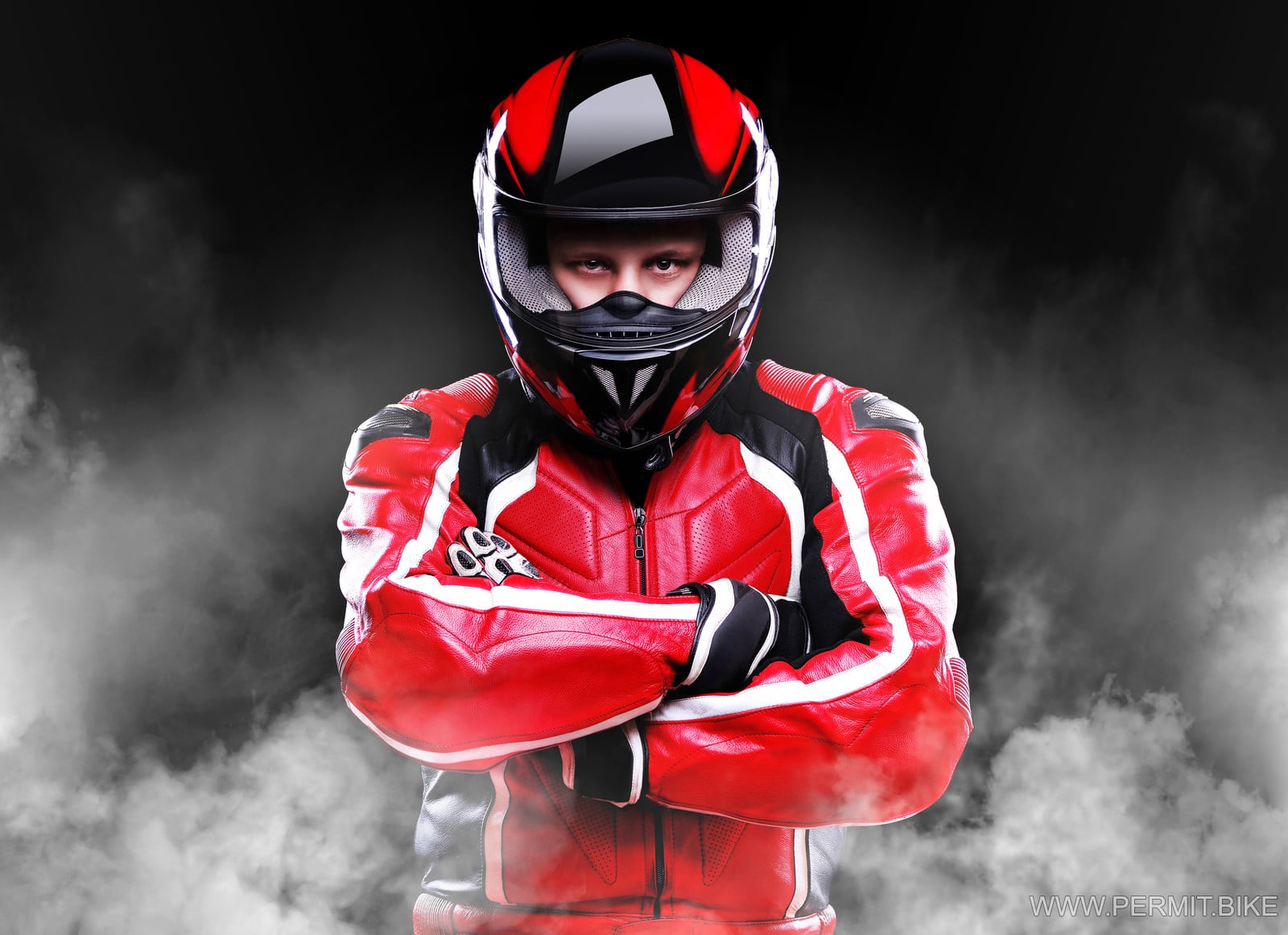
Conveniently for people who are shopping for a motorcycle helmet, organizations exist that test helmet designs to make sure they meet certain minimum standards. These groups test for things such as whether the helmet provides enough peripheral vision while you’re riding and how well it holds up in collisions. It’s wise to only choose a helmet that has received certification from such an organization. This will give you some assurance that the helmet will actually protect you. In America, the standard authority is the U.S. Department of Transportation, which issues rules about minimum safety requirements Take a look at any helmet you consider and see whether it has any certification stickers from the DOT. If not, you should probably move along. That way, you can focus on other considerations without worrying about its basic ability to function correctly.
You should also be aware of an organization called the Snell Memorial Foundation. Formed in 1957 in honor of a sports car racer who was killed by head injuries he sustained while wearing a faulty helmet, the Snell Foundation exists for one reason and one reason only: to promote good helmet design. This foundation performs its own study of helmets independently of the government, and its standards are very stringent. Some experts have criticized Snell for being excessively strict, so the lack of Snell certification doesn’t necessarily mean that a helmet is unsafe. Still, it’s useful for those new to the world of motorcycles to look for the Snell certification sticker while shopping for helmets, even if they aren’t infallible. Alternatively, you can go to the Snell Foundation website to browse a list of certified helmets or look up a specific model to see whether they’ve given it their approval or not.
This might seem obvious, but it bears mentioning, especially if you’re new to motorcycles. A good motorcycle helmet needs to be as comfortable as possible so that it doesn’t interfere with your driving, even when you wear it for an extended period of time. The only way to know for sure if a helmet is right for you is to try it and see. A helmet that’s perfect for someone else may not be good for you.
Should you buy a helmet with an anti-fog coating on the face guard? How about a high-quality ventilation system to keep you cool? The answers to questions like these depend on when, where and why you’re riding a motorcycle in the first place. If you plan to take your bike for a long commute to work every day, for instance, you’ll want to keep in mind the driving conditions you’re going to be facing. If motorcycling is a hobby you only want to pursue when the weather is mild and clear, on the other hand, you won’t need the advanced features on some of the more expensive helmets. One reason there are so many helmets is because different motorcyclists have different needs. Know yours ahead of time, and helmet-shopping will be much easier.
There are six kinds of the motorcycle helmet that you should be aware of before you even begin your search. Nothing will help you narrow down your options faster than knowing what basic helmet type you want. Which ones to consider buying depends heavily on how you’ll use your bike and what you plan on doing while wearing the helmet.
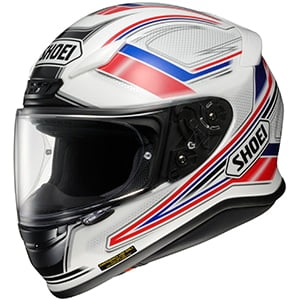
Full-face helmets are the safest, but they’re also relatively heavy and can be hot in warm weather. As the name implies, they protect your entire face, including your jaw, which is often left exposed by other kinds of helmet. In the event that you crash and fall to the ground face-first, that extra protection could be the difference between life and death.
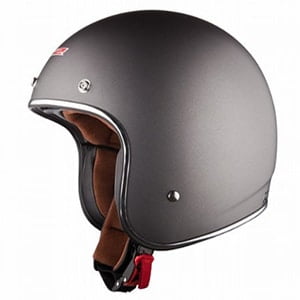 A three-quarter or open-face helmet, on the other hand, leaves your face uncovered, which may allow you greater visibility and allows you access to your face while riding so that you could, say, adjust your glasses. The drawback is that you lose protection in a very vulnerable area.
A three-quarter or open-face helmet, on the other hand, leaves your face uncovered, which may allow you greater visibility and allows you access to your face while riding so that you could, say, adjust your glasses. The drawback is that you lose protection in a very vulnerable area.
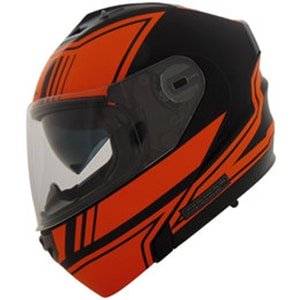 Modular or flip-face helmets try to combine the benefits of the previous two types. They have a chin bar that can be flipped up, meaning that they can function as either full-face or three-quarter helmets depending on what you need. You can keep a modular helmet on while you perform activities like eating, drinking, talking or taking photos. The flexibility is good, and modular helmets are safer than three-quarter helmets when the bar is down. Nonetheless, the presence of a hinge weakens their structure and makes them still somewhat less sturdy than full-face helmets when they suffer an impact.
Modular or flip-face helmets try to combine the benefits of the previous two types. They have a chin bar that can be flipped up, meaning that they can function as either full-face or three-quarter helmets depending on what you need. You can keep a modular helmet on while you perform activities like eating, drinking, talking or taking photos. The flexibility is good, and modular helmets are safer than three-quarter helmets when the bar is down. Nonetheless, the presence of a hinge weakens their structure and makes them still somewhat less sturdy than full-face helmets when they suffer an impact.
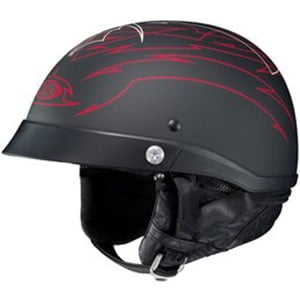 Half helmets are even more minimalist, covering only the top and back of your head. This offers the least amount of protection, but it also makes for a very light and relatively cheap helmet. Safety-conscious motorcyclists will want to avoid these, and they’re especially not recommended for newcomers. If you must buy one, a good, sturdy chin strap is needed.
Half helmets are even more minimalist, covering only the top and back of your head. This offers the least amount of protection, but it also makes for a very light and relatively cheap helmet. Safety-conscious motorcyclists will want to avoid these, and they’re especially not recommended for newcomers. If you must buy one, a good, sturdy chin strap is needed.
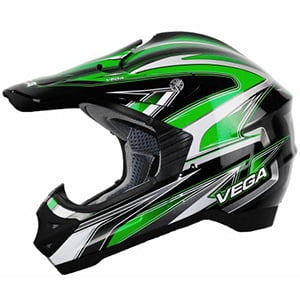 Off-road or motocross helmets can be recognized by their elongated chins and the sun peaks that stick out above the forehead. They’re designed primarily for high-intensity sports biking, so they maximize ventilation but aren’t ideal for highway driving due to a lack of good soundproofing or an aerodynamic shape.
Off-road or motocross helmets can be recognized by their elongated chins and the sun peaks that stick out above the forehead. They’re designed primarily for high-intensity sports biking, so they maximize ventilation but aren’t ideal for highway driving due to a lack of good soundproofing or an aerodynamic shape.
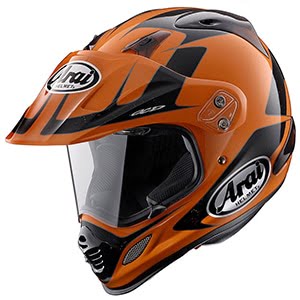 Dual-sport helmets are an attempt to combine the qualities of off-road helmets with those designed for highway riding, making them a good compromise for those who ride bikes for multiple reasons but don’t want or can’t afford to buy two helmets. They’re pointless for those who don’t, however, since more specialized helmets will typically perform better.
Dual-sport helmets are an attempt to combine the qualities of off-road helmets with those designed for highway riding, making them a good compromise for those who ride bikes for multiple reasons but don’t want or can’t afford to buy two helmets. They’re pointless for those who don’t, however, since more specialized helmets will typically perform better.
Getting a helmet of the right size is critical. If your helmet is too loose, then it will jostle around as you drive, which means that it might suddenly obstruct your vision or cause some other distraction while you’re traveling at high speed. On the other hand, if it’s too tight, it might give you a headache, which could also impair your alertness on the road. Finding the perfect fit is crucial. You want a helmet that touches your head but doesn’t put pressure on it. When you’ve tried your helmet on, check to make sure that the cheek, temple, and brow pads rest on your face without pressing down on it. Also, try moving the helmet from side-to-side to make sure that it fits snugly but not too tightly. When you remove it, check for red marks on your skin. If you have any, it’s too tight for you.
As with any other purchase in life, you need to decide what you’re willing to spend. If money is an issue for you, then it’s best to start with something simple for your first purchase. As you gain more riding experience, you’ll gain a better understanding of your needs. There’s a big price range when it comes to motorcycle helmets. The most expensive ones can cost well over $1000. The cheapest can be found for under $100 under the best circumstances. It definitely makes sense to look for affordable options if it’s your first helmet, but you don’t want to sacrifice quality.
A good idea, then, would be to go for something plain, without any fanciful decorations that drive the price up unnecessarily. Of course, if money’s no object to you and you want to look flashy, then by all means spend as much as you want! Otherwise, if you want to decorate your helmet, you can buy separate accessories like stickers that are not only affordable but also allow you to customize your helmet’s look to your unique style.
There’s such a wide variety of helmets that listing all features you might encounter while shopping is nearly impossible. These options will range from very good to totally useless, depending on various factors unique to you. For instance, some full-face helmets have “chin skirts” that help keep you warm in cold weather—more desirable if you live in Minneapolis rather than Miami. Some helmets come with electronic bells and whistles like speakers or communication devices, which can be excellent to have if you want them but aren’t necessities by any means. Look carefully at every feature a helmet has and decide for yourself if you’re going to use them. There’s no need to pay extra for something you don’t need.
Helmets don’t last forever. Even the best of them eventually need to be retired. You should replace your helmet at least once every five years, and that’s only if it’s gone through nothing more than regular wear and tear. Wearing a bad helmet is no better than wearing nothing at all. In fact, it’s possibly worse, since it could fail without notice when you need it the most. It follows that you want to treat your helmet well, making sure that you don’t accidentally break it (and possibly your bank account) before its natural life is over.
Helmets that have suffered unusual stress, such as surviving a road accident, always need to be replaced right away. If you drop your helmet, you don’t necessarily need a new one, but you’ll definitely want to make sure that it hasn’t been damaged and still fits correctly before you put it on and go riding again. Don’t just look at the outside, either, because it’s the soft interior of the helmet that’s most vulnerable to damage.
Protecting the interior of the helmet from sweat and oil by wearing a scarf or bandana can prolong its life. It’s also best to avoid using any hair products if you’re going to be wearing a helmet. If you remove the helmet and notice that the lining is coming out or that it’s leaving little flakes in your hair, you’ll need a new one as soon as possible.
Picking the right helmet is vital to ensure that you’re both safe and in compliance with the law.
When you first start looking for a helmet, the sheer number of options you face may make finding the right one seem daunting or at least boring. However, if you keep all this information in mind, it’ll help you narrow down your choices and make the task much more manageable. That way, you can get the helmet that you need and get down to the real business at hand: riding your motorcycle, confident that you’re well protected as you do so.
https://www.permit.bike/different-types-of-motorcycle-helmets/
https://www.permit.bike/guide-to-buying-a-helmet/
